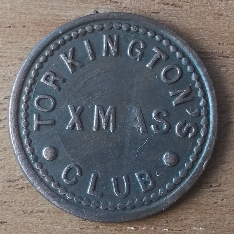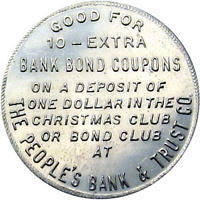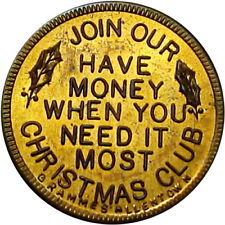
PREV ARTICLE
NEXT ARTICLE
FULL ISSUE
PREV FULL ISSUE
CHRISTMAS CLUB TOKENSTorkington's Christmas Club Token   This is a small token made of copper and has TORKINGTON’S XMAS CLUB on one side and on the other side 1d. There is a place in Cheshire called Torkington but I think it probably is the name of a company rather than a place. It is probably for a factory where employees saved up money each week. Few people had bank accounts in the early part of last century and many clubs, work places and pubs had savings schemes like these. Unfortunately, they were not always safe as the money was sometimes stolen. I remember in the 1960s there was a savings scheme at the village grocers and the butchers as well. Customers would pay a small amount every week and save up for the big day. U.S. Christmas Club Tokens Thanks! A web search for Christmas Club Tokens turned up several others and a short Wikipedia article about U.S. Christmas Clubs, which apparently didn't start until the
early 20th century. Other images and information are welcome. is there any numismatic evidence for U.S. Christmas Clubs before 1909? -Editor
  To read the Wikipedia article, see: U.K. Christmas Club Tokens There is an article on the use of tokens by Christmas Clubs, whereby members saved up for their purchases over the course of the previous year, in my Leaden Token Telegraph newsletter no.115 {pages 3-4}, The tokens were either used as receipts for the money or as pub tokens {drink entitlement vouchers} at the club's meetings. Thanks! Here's an excerpt from the article. -Editor
The concept of saving up for a rainy day, or for a specific event, is not new. The idea of chucking a sum each week or month into the Post Office, bank or building society, in order to lessen the pain of a possible financial outlay when the time comes, goes back further than one might imagine. The organisation which we might trust with our money, or the amount put away, or the means by which we do it; yes, they change, but the concept, no. Some people might even have a special account, distinct from the one which they use for their everyday affairs, for the purpose; imposing a certain discipline on themselves, whereby some money is ringfenced and not allowed to disappear into the general pot. Here we look at some of the ways in which it was done in the past.  Some of you will have worked in offices where one of your colleagues collected small payments each week and there was a big payout in December, ready for the Christmas purchases. Perhaps some of you still do. Others will recall local shops doing the same; the grocer or the butcher, maybe. In those days, even for the older of our current readers, it will have been a paper record that was kept. In the early 20th cent, and perhaps the late 19th, it was sometimes tokens which were used. In the heyday of brass tokens, benefit societies of various types seized upon the token as a way of receipting payments made towards sickness or burial insurance. These societies were often very locally operated, dealing with extremely modest sums. So, when Christmas started to be more generally celebrated in a manner which involved expenditure on items which could not merely be put aside during the year, local shopkeepers jumped on the bandwagon and started operating along similar lines. Many of them had long been deploying metal bonus checks as a way of tempting people with special deals, so the use of tokens was not wholly foreign.  Figs.1-7 show a number of typical examples. The first four state “Xmas Club “ or “Christmas Club” specifically. Fig.5-6 say “Grocery Club” and “Annual Grocery Club”, respectively, but despite the slight anonymity of purpose one feels that Christmas is more than hinted at. All these first six relate to grocers and state a value on the reverse, usually 3d, which seems to have been the popular weekly contribution; because of the sameness of design I have not illustrated every example. Fig.1, which alone manages to state all it wants to on one side, merely repeats it on side two. Fig.7’s issuer is a tailor rather than a grocer and the initials “CC” are again enigmatic, but as we are told that they are not those of the issuer’s name, “Christmas Club” seems the obvious interpretation. To read the complete article, see:  Wayne Homren, Editor The Numismatic Bibliomania Society is a non-profit organization promoting numismatic literature. See our web site at coinbooks.org. To submit items for publication in The E-Sylum, write to the Editor at this address: whomren@gmail.com To subscribe go to: https://my.binhost.com/lists/listinfo/esylum All Rights Reserved. NBS Home Page Contact the NBS webmaster 
|